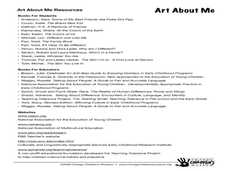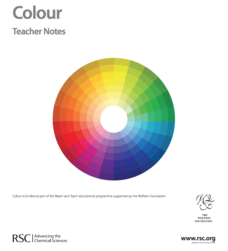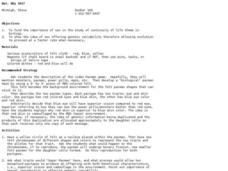Howard Hughes Medical Institute
Human Skin Color: Evidence for Selection
Skin color is controlled by at least six genes. Young scientists learn about skin colors through a documentary. They discuss the topics of pigment, natural selection, and vitamin D absorption. They apply their knowledge to higher order...
Howard Hughes Medical Institute
Zebrafish and Skin Color
You may not know if that zebrafish in your fish tank is a model citizen—but it is definitely a model organism! What can we learn about ourselves from a tiny zebrafish? Discover more about the polygenic trait of skin color through a...
Curated OER
All the Colors We Are
Students make a hand print mural. In this painting lesson, students read the book All the Colors We Are and describe the color of their skin. Students learn how to mix paints to create various skin tones, create their personal color and...
Curated OER
Art About Me- The Skin You Live In
Students read the text The Skin You Live In by Michael Tyler. In this literacy lesson, students discuss the characters in the text and the various shades of skin they observed on each page. Students read the beautiful descriptions of the...
Chymist
The Extraction and Identification of Artificial Food Colors
Did you know some food dyes are considered safe while others are considered carcinogenic? During the experiment, young chemists extract artificial food colors from prepared foods. Then, they use chromatography paper to identify which...
It's About Time
Color
How can a hand puppet's shadow look like a dog? The lesson explains the science behind shadows, combining paint colors and the colors used in old televisions. Scholars use white, red, blue, and green lights to experiment with colors and...
Howard Hughes Medical Institute
Understanding Variation
Does where we live influence how our bodies express genetic traits? Explore variation in human skin color with an activity that incorporate video and hands-on learning. Individuals model the relationship between phenotypes and genotypes,...
Curated OER
Colors of My Skin
Students cooperate in small groups to prepare paint colors that match their own skin colors. They share a variety of paint colors which they mix individually to create a shade that matches their own skin tone. They discuss the colors...
Curated OER
ESL-Colors
In this ESL colors worksheet, students listen to a song titled "Sing a Rainbow," then sing the song and complete a "color" crossword puzzle.
Arkansas Government
Creative Adventures with Literature - Whoever You Are
Celebrate our similarities and differences through multiple readings of Whoever you Are by Mem Fox. Readings are accompanied by a grand discussion, charts, creative art, dramatic, and music play to reinforce the uniqueness that is found...
Anti-Defamation League
Bellen Woodard, Identity, and “Crayon Activism”
Scholars learn about a young child turn activist and author, Bellen Woodard. Learners discuss identity, the importance of representation, and how activism makes a difference. Small groups brainstorm ways to create change and the steps to...
Royal Society of Chemistry
Colour—Gifted and Talented Chemistry
Add a splash of color to your chemistry class! Science scholars discover the principles behind color through a wide variety of hands-on activities. Lessons include dyes, chromatography, and flame tests.
Curated OER
UV Rays, sunscreen effectiveness
Students identify and define that invisible UV rays can be harmful. Then they explore the effects of UV radiation on objects that react UV rays and what products are most effective in blocking UV rays. Students also make predictions...
Curated OER
LESSON 3: The Many Shades of Our World
Students recognize that people have many different types of skin color.
Curated OER
I Am Special, You Are Special Too #2
After being read a story, the students attempt to identify one individual difference, and one thing about themselves that is similar to other students in the class and one thing that makes them special. For the art lesson, students...
Curated OER
Becoming More Comfortable in Your Inherited Skin
Students examine their concepts of "beautiful" and "ugly" and the social influence on this perception. They look more closely at the role genetics plays on determining the way a person looks. Students explore ways to enhance their own...
Curated OER
COLORS ON THE FARM
Students follow directions regarding what colors farm objects should be
colored. They identify various items pictured on provided worksheet that can be found on a farm or are made from farm animals. Finally, they match each color crayon...
American Museum of Natural History
Dress up a T. Rex
Scholars play with an image's color and brightness to predict how tyrannosaurus rex's skin, feathers, and eyes would have appeared. Information and real-world pictures shed light on what evidence guides our assumption of how a dinosaur...
Curated OER
The Many Shades of Our World
Students discover diversity. For this civil rights lesson, students consider that skin color is unique and that diversity is common in the world as they complete artwork that reflects the writings of Dr. Martin Luther King, Jr.
American Institute of Architects
Architecture: It's Elementary!—First Grade
Build an interest and appreciation for architecture in your young learners with this fun 10-lesson art unit. Engaging children in using their five senses, the class first observes the environment around them, paying special attention to...
Curated OER
But, Why Sex?
Students investigate the importance of sexual reproduction in evolution. In this sexual reproduction lesson plan, students simulate species with two traits: eye and skin color. They determine what characteristics are beneficial for the...
Curated OER
Figure Analysis
Students identify the importance of the Principles and Elements of design through self-analysis and sketching clothing appropriate for their body type. They write the actual color name on a line of the included sheet, then describe why...
Biology Junction
Amphibians
Biologists know of more than 2,300 living species of amphibians. Learn more about the four orders of amphibians with an interesting presentation. It explains the similarities and differences between the thousands of species of...
American Chemical Society
Combustion and Burning
On Earth, a candle flame points up, but on the International Space Station, it forms a sphere. Young scientists practice their skills by recording observations before, during, and after a candle burns. Chemical and physical changes...

























